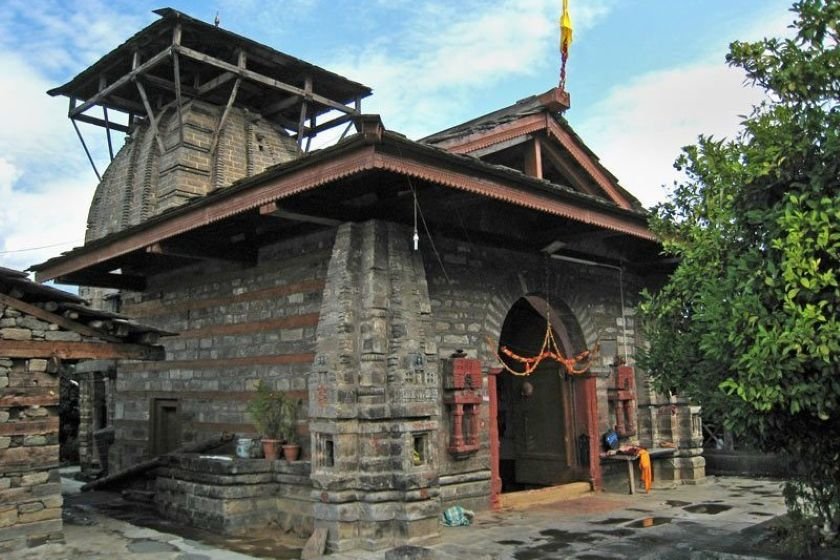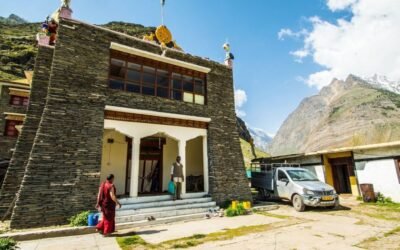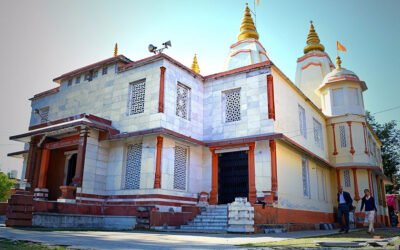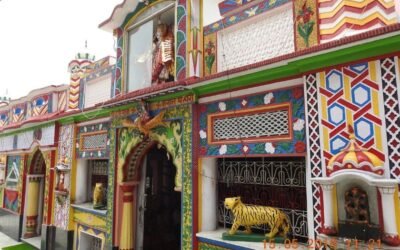Where Radha’s love lingers in stone and Krishna’s murli echoes through pine
Perched on a quiet hilltop above the ancient town of Naggar, the Murlidhar Krishna Temple in Thawa village is a 1,000-year-old sanctuary dedicated to Lord Krishna, worshipped here as Murlidhar—the bearer of the flute. This lesser-known yet spiritually potent shrine is a gem of the Kullu Valley, offering not just divine presence but also breathtaking views of the Beas River and surrounding peaks.
🌄 Location & Accessibility
- Location: Thawa village, ~5 km uphill from Naggar, Kullu District, Himachal Pradesh – 175130
- Altitude: ~1,900 meters
- By Road: 26 km from Kullu, 21 km from Manali; taxis available till Naggar
- Trek: A short but steep 25–30 minute uphill walk from Naggar Castle
- By Air: Bhuntar Airport (~35 km)
- By Rail: Joginder Nagar (~125 km) or Pathankot (~270 km)
🕉️ Deity & Worship
The temple is dedicated to Lord Krishna, enshrined here as Murlidhar, with a black-faced idol playing the flute, accompanied by idols of Radha, Garuda, and Lakshmi-Narayan. The sanctum radiates a quiet intimacy, drawing devotees who seek love, devotion, and inner harmony.
The goddess is worshipped in the form of three pindis, representing Maha Kali, Maha Lakshmi, and Maha Saraswati.
Devotees offer red flags, coconuts, and sweets, and the temple is especially known for fulfilling wishes of childless couples and those seeking justice. Rituals include chanting of Krishna bhajans, offering of tulsi leaves, and lighting of ghee lamps. A small wooden rath (chariot) is kept beside the temple and used during Dussehra processions, when the deity is paraded through the village in celebration.
🏛️ Architecture & Setting
The Murlidhar Temple is built in the Nagara style, with a pyramidal shikhara (spire) and stone-carved sanctum. Though partially rebuilt after the 1905 Kangra earthquake, the temple retains its medieval charm, with weathered stone steps, carved doorframes, and a courtyard scented with citrus and honeysuckle.
The temple sits on a terraced ridge, offering panoramic views of the Kullu Valley, and is surrounded by pine forests, wildflowers, and the occasional call of Himalayan birds—a setting that feels like a natural ashram.
📜 Mythological Significance
While not directly tied to a specific episode from the Mahabharata, the temple’s presence in Thawa, a site older than Naggar itself, links it to the ancient spiritual geography of the Beas Valley. The Radha-Krishna murti here is said to have been consecrated by local sages, and the temple has long served as a center of Vaishnavite devotion in the region.
🎉 Festivals & Celebrations
- Janmashtami: Celebrated with bhajans, midnight aarti, and community feasts
- Dussehra: The deity is taken out in a wooden rath as part of the local procession
- Daily Worship: Includes morning and evening aartis, tulsi offerings, and recitation of Vishnu Sahasranama
🏞️ Nearby Attractions
- Tripura Sundari Temple: A Shakti shrine with intricate woodwork and panoramic views
- Jagatipatt Temple: The sacred stone seat of the valley’s devtas
- Naggar Castle: A heritage fort with Kathkuni architecture and a museum
- Nicholas Roerich Art Gallery: Celebrating the Russian mystic who made Naggar his home
🙏 Spiritual Experience
The Krishna Temple of Thawa is not just a place of worship—it is a hilltop hymn, a flute note frozen in stone, where Radha’s longing and Krishna’s grace still linger in the mountain air. As you sit in its quiet courtyard, with the valley unfolding below and the murli echoing in your heart, you realize this is not just a temple—it’s a love story carved into the Himalayas.




